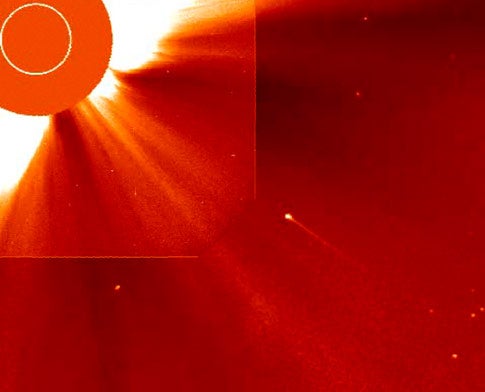To date, astronomers credit the Solar and Heliospheric Observatory (SOHO), a joint mission between NASA and the European Space Agency, with discovering 1,089 comets in 10 years of operation. Although the satellite’s main job is watching the Sun, SOHO has become history’s most successful comet-finder.
About 90 percent of SOHO’s comets are members of the Kreutz sungrazing family, which, until 2002, was the only comet group astronomers could identify confidently. Astronomers define a comet group as more than two comets bearing almost identical orbital elements, either now or at some earlier time. In “Sungrazing comets,” Zdenek Sekanina explains how fragments from a single giant comet nucleus could account for all of the Kreutz sungrazers astronomers had discovered through 1970.
| Catch a SOHO comet |
| Most SOHO comets have been found by amateur astronomers who scoured images from the spacecraft made available on the Internet.
In fact, anyone with a computer, an Internet connection, and lots of free time can take up the search. You’ll find all the information needed to get started at the U.S. Naval Research Laboratory’s SOHO Comets site. The challenge: Find an object that isn’t a star or planet moving in a straight line through at least five frames, measure its position, and report it to SOHO Comets. The site also lists when planets or bright stars will appear in images from SOHO’s LASCO C3 instrument. For example, on November 11 and 12, Mars, Mercury, Venus, and Jupiter will be visible at the same time. There’s also a Java-based applet that makes it easy to measure the positions of a possible new comet. |
By 2002, thanks to SOHO’s finds, astronomers began to see relationships between many non-Kreutz comets, too. For example, Brian Marsden at the Harvard-Smithsonian Center for Astrophysics pointed out that C/1999 J6 and 1999 U2 reached perihelion exactly 4.5 months apart, while Maik Meyer in Kelkheim, Germany, noted that C/1997 L2 and 2001 X8 rounded the Sun exactly 4.5 years apart. Both noted each pair had likely associations with several other comets, and the Marsden and Meyer comet groups were born.
The Meyer family now has 64 possible members; the Marsden group, 23. It’s tough to be certain because SOHO observations cover such a short orbital arc. Some of these objects may be unrelated short-period comets.
In the past few years, astronomers have recognized one additional group named for Rainer Kracht of Elmshorn, Germany. Kracht is the current SOHO comet champion with 164 finds to his name. The group contains 31 members, but at least three comets appear to make up a separate family, which astronomers have tentatively dubbed Kracht II.
Unlike the well-defined Kreutz comets, the Kracht group comets appear to branch from a messy family tree. First, the Kracht group bears strong relationships to the Marsden group. And both of these families appear to be linked with the annual Quadrantid meteor stream, and possibly others. In 2003, astronomers discovered 2003 EH1 — an object now thought to be the source of Quandrantid meteors. But this object, which may be the burned-out core of a comet, is classified as an asteroid.
As SOHO and its successors continue taking the census of small comets, astronomers will continue to use them to unravel family ties among the solar system’s smallest members.










